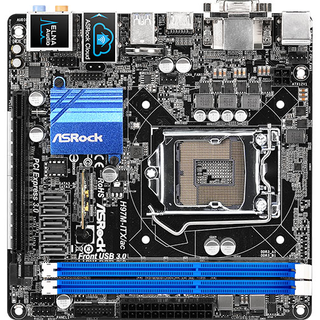Why you can trust Tom's Hardware
ASRock H97M-ITX/ac
ASRock's H97M-ITX/ac rectifies some of the H81M-ITX's issues with plenty of SATA 6Gb/s ports, front-panel USB 3.0, wireless networking and decent audio. In the box, you get two SATA cables, a CD, manual, the wireless card, antenna wires and antennas, and the I/O plate. You also get a little metal bracket that screws to the board on one end and to the wireless card for support at the other. I'd like to see another SATA cable or two, but I suspect a lot of builders have boxes of them. The antenna wires run to connectors that are then bolted to cutouts on the I/O plate, and the antennas screw in on the outside.



This board also places the CLR_CMOS jumper to the right of the 24-pin power connector along the front of the board, not near the battery, but easy to reach. The wireless card takes up enough of the available space on the board that the battery is vertically mounted behind a couple of the rear panel’s USB3.0 ports. It is the ubiquitous CR2032. The CPU fan header is on the right behind the PS/2 connector, and the chassis fan connector (a 4-pin PWM) is centered horizontally but toward the back, and nowhere near any cable management openings. Reversing those two would have made sense. Unlike the depiction on the [stock] photo above, the RAM slots have locking levers on both ends, so you can be sure your RAM is fully inserted. Since the SATA ports are not on an edge, but are left of the PCIe slot and behind the RAM, you will have a bundle of cables there if you plan to use more than a couple of drives. They are also aligned the same way, so if you’ve used locking cables, once they are placed, you may need to remove one or more in front of one you want to change to get at its clip. There is again no case speaker header. The single USB2.0 header on the board is behind the front panel header on the left front edge. The USB3.0 header is between them and the power connector. As usual, ASRock uses all solid capacitors and ferrite core chokes.
The initial UEFI screen looks a lot like that of its previously-discussed sibling, though perhaps a little more subdued:
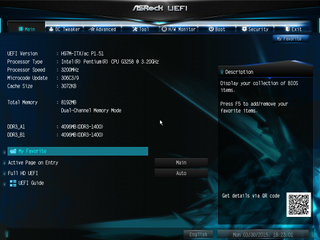
Similarly, the OC Tweaker can easily bump the Pentium to a number of different performance levels. For me, 4GHz was stable using the Non-Z OC setting.
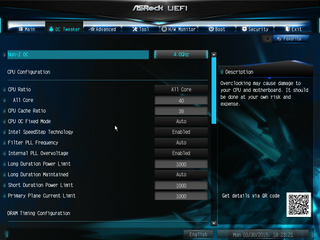
This presented the expected results:
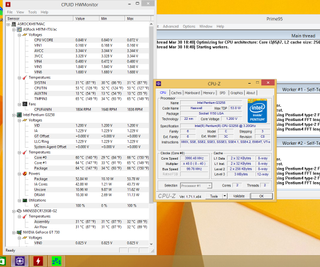
Looking back at my past half-dozen builds, there's nothing I truly needed that isn't on this board. Sometimes I overclock, but I often run stock clock rates and use a single graphics card. Optical drive, system drive, and RAID 1 can all be accommodated. The $80 price isn't too bad either; a similar microATX board (minus Wi-Fi) goes for $70. Especially if you want a small system, there's nothing here not to like.
I learned another great lesson from this board. Moving its wireless antennas, which were originally placed behind the case, to someplace higher (away from the PSU) improved performance considerably. I ran multiple tests at different times, and saw much better throughput. Let's revisit the speedtest.net numbers:
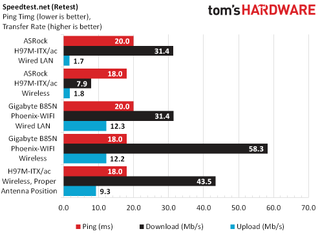
Clearly, antenna positioning can be a really big deal. ASRock doesn't quite catch up to Gigabyte, but these are still solid results. Particularly with that notable issue out of the way, a summary of this board is that it’s small and includes excellent storage options (including RAID). It also includes front-panel USB 3.0, wireless networking and decent audio.
Stay on the Cutting Edge
Join the experts who read Tom's Hardware for the inside track on enthusiast PC tech news — and have for over 25 years. We'll send breaking news and in-depth reviews of CPUs, GPUs, AI, maker hardware and more straight to your inbox.
-
PaulBags Fix ya damn website tom's, why take up 60% of the screen with a "recommended article" while I'm trying to read this one, with a close button that doesn't work? Android 4.4.2, default browser, desktop mode.Reply -
Firion87 Dear Tom's. I own the Gigabyte B85N Phoenix for 2 months. Never measured the power draw but I'm using an Intel m-sata 530 SSD and that thing gets hot! I build some sort of duct above it with a 40mm fan to try cooling that thing from 56 degree Celsius to at least 48 which still seems a lot to me. The duct extends and covers also the chipset which stays nicely around 28 degrees. There's nothing else negative to report from this board. Everything works.Reply -
DonkeyOatie Thanks for the validation.Reply
http://www.tomshardware.com/forum/id-2625445/build-log-consolidated-middle-school-builds.html
My students have been building successfully with the ASRock H97 ITX/ac and it does everything you say. What challenges there are, like getting those tiny connectors on the WiFi card to fit into the sockets on the antenna wires, add texture, and frustration, to the building experience.
All customers are satisfies at the moment and we are trying a Z97E ITX/ac build now.
The i5 4460/GTX970 configuration is being updated to a GTX 980 and 4k monitor. -
akula2 Interesting article.Reply
Some folks may consider to pay a bit more for AsRock Rack boards if they are looking for personal or enterprise-grade storage (NAS server/box) based on ZFS. E.g., a typical home box config:
1) Core i3 4360T (35W) + C226M WS uATX board + 8GB ECC RAM -
Onus It looks like prices have changed again since I tested these boards.Reply
The more I think about it, the more I like the H97 chipset; the only thing you really give up is overclocking "K" CPUs. In the old days, you almost had to overclock to get good performance, but CPUs are so much faster today it seems less of a requirement unless you're down in Pentium territory; but that one can be overclocked on H97. -
dvanburen Reply15857592 said:Thanks for the validation.
http://www.tomshardware.com/forum/id-2625445/build-log-consolidated-middle-school-builds.html
My students have been building successfully with the ASRock H97 ITX/ac and it does everything you say. What challenges there are, like getting those tiny connectors on the WiFi card to fit into the sockets on the antenna wires, add texture, and frustration, to the building experience.
All customers are satisfies at the moment and we are trying a Z97E ITX/ac build now.
If you can justify the additional cost you should like the Z97E ITX/ac. I have both of these boards in different builds. While the H97M ITX/ac is a nice board, the Z97E ITX/ac is nicer all around. For me it is about a $30 USD premium.
-
Onus I built a rig on the Z77E-ITX, and it was my primary for months (its name was Gypsy, and true to form, it eventually wandered off to join the Circus; I sent it to some friends who have six minions). It was a nice board, and I could see buying another one for the i5-3570K from a different build that is now idle. It had a mSATA slot on its underside for a SSD. One gotcha: The mSATA screw was not included, and if whatever you used was long enough to short to the case, the board would not boot; a piece of electrical tape fixed that.Reply
-
dvanburen It's interesting that their use in an HTPC was mentioned in the article. I'm using an H97M ITX/ac for just this purpose. However, I don't think most will use the onboard audio as I believe HDMI will be used in the majority of HTPC builds. To be honest, the only reason I went this route is because I already have a very nice case with a VFD, a decent PS, and drives. If I was to start from scratch I would probably use something like the MSI Cubi. That is, if I could live without the VFD...Reply -
Karsten75 Could you only get boards from ASRock and Gigabyte? I'm not too sure I understand testing two much older chipsets against a more modern chipset. The price points are also way off. Why pay as much for a B85 chipset motherboard as for a H97??Reply -
Onus All the "big boys" were invited to send boards. Only ASRock sent any; two. Some specifically expressed disinterest. Tom's bought the Gigabyte board.Reply
I'm working on more boards now. Once again, ASRock has sent two. I bought one, and I believe Tom's is buying others.
As to the prices, they've jumped around in the last month or so.
One thing I think the article showed is that the price jump from H81 to another chipset buys quite a bit.
As to B85 vs. H97, it depends on your uses. In this case, Gigabyte's superior network adapters are worthwhile if you don't care about specific H97 features like RAID.

